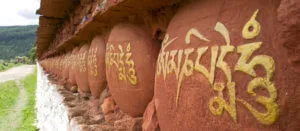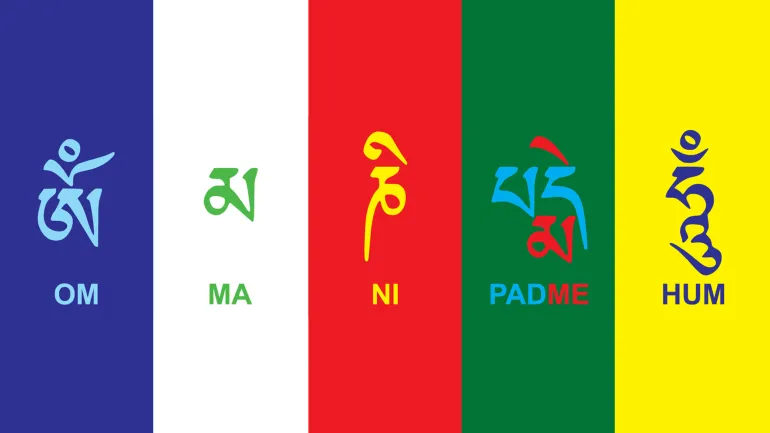Meaning of Om Mani Padme Hum
“Om Mani Padme Hum,” the six-syllable mantra, is one of the most well-known and revered mantras in Tibetan Buddhism. Often associated with Avalokiteshvara (Chenrezig in Tibetan), the Bodhisattva of Compassion, this mantra is believed to embody the essence of compassion and wisdom. The phrase is chanted, inscribed on stones, prayer wheels, and various sacred objects, and forms an integral part of Buddhist practice. This article explores the historical background, linguistic breakdown, spiritual significance, and practical applications of “Om Mani Padme Hum.”
Historical Background
Origin in Mahayana Buddhism
The mantra “Om Mani Padme Hum” has its roots in Mahayana Buddhism, particularly in the traditions of Tibetan Buddhism and Vajrayana Buddhism. Avalokiteshvara, the Bodhisattva associated with this mantra, is considered the embodiment of boundless compassion. His name means “The Lord Who Looks Down (in compassion),” and he is venerated across various Buddhist cultures.
Spread and Influence
As Buddhism spread from India to Tibet, China, Japan, and other parts of Asia, the mantra also gained prominence. Tibetan Buddhism, with its rich tradition of mantras and ritual practices, particularly embraced “Om Mani Padme Hum.” The mantra became a core element of Tibetan spiritual life, seen in prayer wheels, prayer flags, and mani stones inscribed with the mantra placed along paths and roads.

Linguistic Breakdown
OM
Om is a sacred sound that combines three syllables, A, AU, MA, each representing a different aspect of our being. A symbolizes our body, AU symbolizes our speech, and MA symbolizes our mind. However, due to our deep-rooted negative emotions such as anger, hatred, and jealousy, our body, speech, and mind are often impure. The question then arises: How can we transform our impure nature into purity? The answer lies in the remaining syllables of the mantra.
MANI
Mani, which translates to “jewel,” metaphorically represents the most precious treasure that resides within each of us. What is this treasure? It is our altruistic attitude—an innate inclination to help others or, at the very least, to refrain from causing harm.
However, our altruistic nature and our self-centered tendencies are often at odds. When events or behaviors do not align with our desires or specific conditions, our self-centeredness tends to surface. How, then, can we cultivate altruism and transform our self-centered attitudes? One of the most effective ways is to purify our negative thoughts and intentions.
PADME
Padme, meaning “lotus,” symbolizes the purification of our minds, akin to the lotus flower that emerges pure from the muddy waters. Similarly, we must cleanse our minds of impurities, and the most effective way to achieve this is through wisdom—specifically, understanding reality as it truly is.
Wisdom involves recognizing impermanence and the interdependence of all things. While there are various forms of wisdom, the ultimate wisdom is that which realizes emptiness—the concept that nothing exists independently; everything is interconnected.
HUM
By combining wisdom (realizing emptiness) with altruistic intentions, we can gradually transform our impure body, speech, and mind into a state of purity. This transformation is a continuous process that requires dedication and practice, as change takes time to manifest.


His Holiness the Dalai Lama emphasizes the importance of not just reciting the mantra Om Mani Padme Hum but also contemplating its profound meaning. Each of the six syllables carries immense depth and significance, making it essential to reflect on its meaning while reciting it.

Spiritual Significance
Compassion and Wisdom
“Om Mani Padme Hum” is believed to encapsulate the essence of compassion (karuṇā) and wisdom (prajñā). Avalokiteshvara, the Bodhisattva of Compassion, embodies these qualities. By chanting the mantra, practitioners aim to develop these attributes within themselves.
Purification and Transformation
Each syllable of the mantra is thought to purify specific negative emotions and mental states, transforming them into positive qualities. For instance, “Om” purifies pride, “Ma” purifies jealousy, “Ni” purifies passion, “Pad” purifies ignorance, “Me” purifies greed, and “Hum” purifies hatred. This transformative process is central to Buddhist practice and the path to enlightenment.
Connection to Avalokiteshvara
Chanting the mantra is also seen as a means of invoking the blessings and presence of Avalokiteshvara. Practitioners believe that reciting the mantra aligns their minds with the compassionate nature of the Bodhisattva, fostering a deep sense of connection and spiritual support.
Practical Applications
Chanting and Meditation
One of the primary ways practitioners engage with “Om Mani Padme Hum” is through chanting and meditation. Regular recitation of the mantra, often accompanied by visualization of Avalokiteshvara, helps to cultivate a focused and compassionate mind. The rhythmic repetition aids in calming the mind and deepening one’s meditation practice.
Prayer Wheels and Flags
In Tibetan Buddhism, prayer wheels and prayer flags are inscribed with “Om Mani Padme Hum.” Spinning prayer wheels or hanging prayer flags is believed to release the mantra’s spiritual energy into the world, spreading blessings and compassion. These practices are seen as ways to accumulate merit and bring positive transformation to oneself and others.
Mani Stones
Mani stones, rocks carved with the mantra, are placed along paths, rivers, and sacred sites in Tibetan regions. Pilgrims and devotees create these stones as acts of devotion, believing that the presence of the mantra in the landscape imbues it with spiritual significance and protection.
Daily Life
Practitioners are encouraged to integrate the mantra into their daily lives, using it as a tool for mindfulness and compassionate action. By reciting the mantra during routine activities, individuals can maintain a connection to its spiritual power and foster a compassionate attitude throughout their daily interactions.
Conclusion
“Om Mani Padme Hum” stands as a timeless and powerful mantra, encapsulating the essence of compassion, wisdom, and spiritual transformation. Its historical significance, linguistic depth, and practical applications make it a cornerstone of Tibetan Buddhist practice. Whether through chanting, meditation, or integrating its principles into daily life, practitioners continue to find profound inspiration and guidance in this six-syllable mantra. As “Om Mani Padme Hum” transcends cultural and religious boundaries, it continues to offer a universal message of compassion and wisdom, resonating with people worldwide and fostering a deeper connection to the path of enlightenment.
Related Video
FAQ
What are the benefits of reciting “Om Mani Padme Hum”?
Reciting “Om Mani Padme Hum” is believed to purify negative karma, cultivate compassion, and deepen wisdom. It can bring inner peace, reduce suffering, and create a positive impact on oneself and others. The mantra’s rhythmic repetition promotes mindfulness and can lead to spiritual transformation and enlightenment.
How does “Om Mani Padme Hum” relate to Avalokiteshvara?
“Om Mani Padme Hum” is associated with Avalokiteshvara, the Bodhisattva of Compassion. The mantra embodies Avalokiteshvara’s compassionate essence, and chanting it is believed to invoke his blessings. Avalokiteshvara is often depicted holding a lotus flower, symbolizing purity, and a mala (rosary) representing the continuous recitation of the mantra.
How do you use a prayer wheel with “Om Mani Padme Hum” inscribed on it?
To use a prayer wheel inscribed with “Om Mani Padme Hum,” hold it in your right hand and spin it clockwise with a gentle motion. As you spin the wheel, visualize the mantra’s syllables radiating blessings and compassion, benefiting all beings. Each spin is considered equivalent to reciting the mantra orally.
FOLLOW US ON





https://babu88-in.com/
Very valuable piece
Analogues exist?
What words… super, a remarkable phrase
Completely I share your opinion. It is good idea. I support you.
Могу предложить зайти на сайт, с огромным количеством информации по интересующей Вас теме.
Just that is necessary, I will participate. Together we can come to a right answer.
http://forum.aboutbulgaria.biz/viewtopic.php?f=15&t=70394
http://freestyler.ws/user/519714/winnitalycom
https://1xbetvnlogin.com/